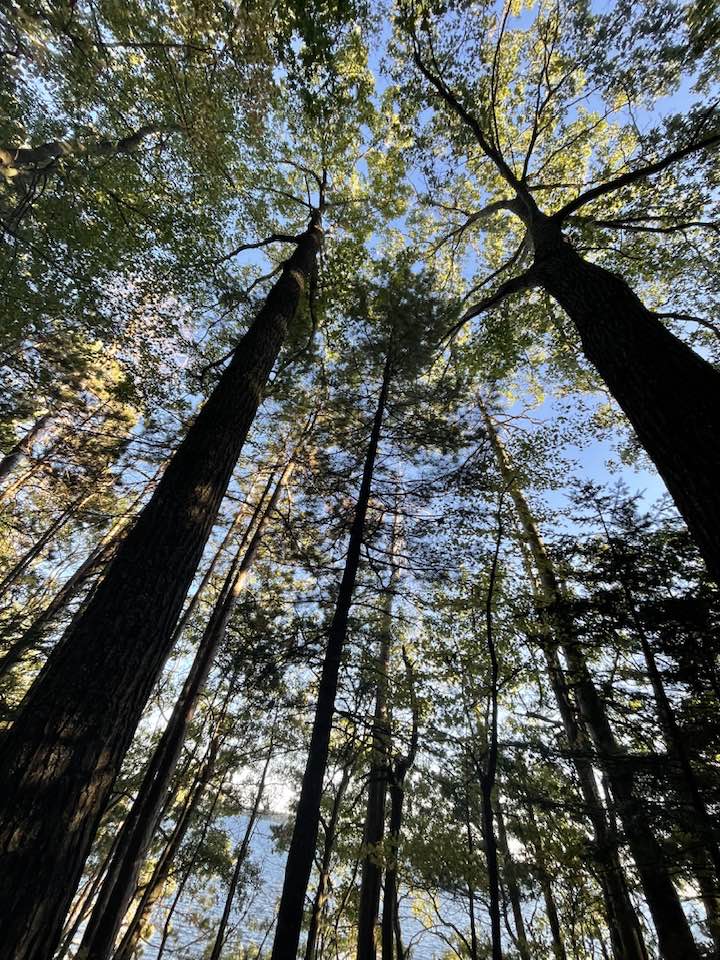SEPTEMBER 23, 2024 – This morning the air outside was as still as it was inside the Red Cabin. Overnight the temperature had dropped into the 40s, and in the hour after daybreak, the mercury hadn’t yet climbed above 48. I donned appropriate clothing and slipped out for a walk along the shoreline path to the opposite end of Björnholm. Still close to the horizon, the sun cast its fresh rays on tree branches that stuck out over the glassy surface of the lake. The air was so calm not single leaf stirred—not even the swivel-stemmed poplar leaves gave a hint of movement. From higher elevations along the path I peered down the tree-guarded slopes straight into water, so clear and calm that sand and stones on the lake bed were visible 20 feet out from shore.
I pressed on to the far end of the property, where I turned around for a very different view of the lake, woods and morning light. Though I’ve walked this route a thousand times, I saw things—big things—for the first time. More precisely, I noticed things for the first time. This “first time” concept, I’ve . . . noticed, occurs with increasing frequency in older age. That is, things that I’ve seen before, often with regularity, come into perspective in ways that until now I was too dull, too hurried, too distracted to appreciate.
This morning what impressed me most of the things I noticed “for the first time” were two huge old oaks at the east end of our property. They stand close to the path and are so old the first branches are more than 30 feet above the ground. Each has a girth of close to two feet, and their interlocking crowns are lush and healthy. I stopped to admire these amazing arbors, and as I craned my neck to see their lofty heights, I estimated that the two trees are close to 100 feet tall. Plus, they stand atop a steep bank that’s 40 feet above the lake. These oaks would be midgets next to giant redwoods, but in this corner of the globe, the twin pillars are royalty among the local hardwoods.
How is it that only now have I noticed their grandeur? In fairness to myself, however, those two oaks are considerably bigger and taller today than they were when I was a kid. Moreover, I don’t frequent that part of the trail nearly as much as I walk the rest of the property. Still, as I leaned on one to steady my upward gaze, I was surprised that I was noticing—appreciating—these two magnificent oaks for the first time.
While doing so, I noticed another tree for the first time and standing between the two oaks. This third stalwart is a white pine nearly as old as I am. Its top is below the oak crowns, but the pine is well-positioned for a break-through someday in the years ahead.
Dad was a big fan of oak and pine, especially the white pine, and he loved repeating his observation about the latter; that when they hit the underside of the hardwood story, the white pines would “needle their way through,” as he described their persistence, until they’re in the clear. Once they’ve re-discovered the unobstructed sunlight, they grow audaciously, fanning out horizontally at the same time they reach for the sky.
This morning when I noticed the pine, I saw that it would have little need to “needle”; that in another five years or so, it would push straight through a gap between the oak crowns and spread its wings.
While I strode back along the path toward the Red Cabin, I reached a grove of old Norways where an eagle had no doubt been eyeing my progress. The regal bird created a mild disturbance with its enormous wings as it dropped from its perch and soared along the shore ahead of me. Here, bald eagles are as common as crows; every day we’re up here we see the raptors. But for the first time I noticed the speed of the eagle as it flew past the trees, which appeared as markers on a giant linear speedometer.
For much of the rest of the day I worked in the “tree garden,” doing trail maintenance and pruning a tier or two of lower branches on the larger white pine saplings. Throughout the effort, I noticed much . . . “for the first time,” especially the latest crop of volunteer white and red pine seedlings, visible now that the ferns that obscured them through the summer months have yellowed to shortened daylight.
Subscribe to this blog and receive notifications of new posts by email.
© 2024 by Eric Nilsson
